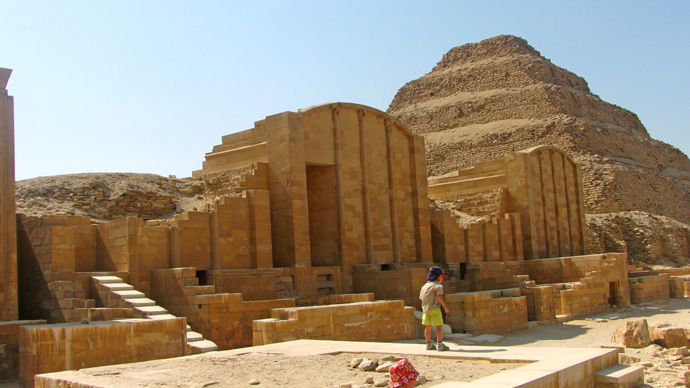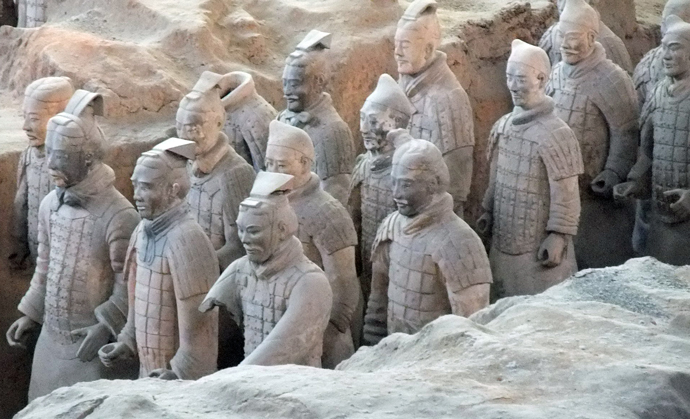< flame-like earthenware, Niigata Prefecture, japan, About 5000
years ago >
This time, we
look at primitive fine arts of Japan and China.
The
characteristic fine arts will teach us the life of the primitive.
今回は、日本と中国の原初美術を見ます。
その特色ある美術から原初の暮らしが見えて来ます。
< left, The oldest clay figure, about 6cm in height, Ibaraki
Prefecture, about 8000 years ago. right, a clay figure is called ” Venus” ,
Nagano Prefecture, 27cm in height, about 5000 years ago. >
The world’s first earthenware was made in Japanese Islands at 12000
years ago.
In those days the people settled in a place while they were hunting,
gathering and fishing, because blessings of nature were rich.
It enabled manufacture of the earthenware and the clay figures.
The clay figures had continued to be made for about 8000 years, and it
was over as wet-rice farming
was popular.
Above-mentioned
the oldest clay figure resembles the Venus image of about 15000 years ago in
Siberia. ( refer to “Birth of primitive art 3”)
In the last half
of this epoch, the characteristics of woman became to be inconspicuous from the
clay figures.
And decoration
and deformation became to be conspicuous.
Then realistic
animal clay figures also became to be made.
Although the excavated
clay figures totaled about 15000, these have damaged almost.
Perhaps, people broke them intentionally for the
purpose of the prayer.
日本列島では12000前頃から世界で最初に土器が作られた。
当時、狩猟採集漁労生活ではあったが、山野の恵みが豊なことにより定住を行っていた。
このことが土器や土偶の製作を可能にし、土偶は約8000年間作られ続け、水稲栽培が普及すると終焉を迎えた。
上述の最古の土偶は約15000年前のシベリア出土のビーナス像に似ている。(原初美術の誕生3:動産美術の展開に詳しい)
しかし縄文時代後半になると土偶の人物像は女性の特徴が目立たなくなり、装飾や強いデフォルメが目立つようになる。また写実的な動物像も作られるようになる。
その出土総数は15000体ほどあるが、大半が破損しており、祈祷目的で故意に壊したものらしい。
< big eyes clay figure,
Aomori Prefecture, about 3000~2300 years ago >
This is one of clay figures in the last half of this epoch. Its eyes are emphasized.
これは後半の土偶の一つであるが、目が強調されている。
< the oldest kinds of earthenware >
Although earthenware was made for cooking,
before long, its ornament became to be important.
A flame-like earthenware of infographic topping had appeared suddenly, and disappeared after
about 1000 years.
This is considered
to be a thing for not daily necessities but religious service.
土器は煮炊き用に製作されたが、やがて装飾が重視されるようなった。
巻頭写真の火焔土器は突如として出現し、千年ほどで消えた。
これは実用品ではなく祭祀用のものと考えられる。
The feature of these fine arts
In primitive fine arts of Japan, there
are neither realistic drawing nor life scenes almost.
Of course, there is neither cave mural
paintings nor big lock arts.
Probably, the reason depends to a large extent on the settled life
and hunting small animals and gathering nuts.
The clay figures
and earthenware that was made of clay were in close contact with their lives.
While every
locations interplay, these fine arts grew on the whole in Japan islands. Those
days, a royal power did not exist.
この美術の特徴
日本では、写実的な描画や生活場面が描かれることはなかった。
もちろん洞窟壁画も大きなロックアートもない。
その理由は、小動物と木の実、遡上する魚などに依存する狩猟採集と定住生活が大きく影響したのでしょう。
材料がすべて粘土である土偶や土器は、生活と共にあった。
各地が交流しながら、この美術は列島全体で発展していった。当時、王権は存在していなかった。
What place was Japanese Island that developed these?
The places where
typical clay figures and earthenware were made are Nagano Prefecture and
Niigata Prefecture, and there are at the center of the Japanese Islands.
これらを育んだ日本列島はどのような所だったのか。
代表的な土偶や土器が作られた場所は長野県や新潟県で、日本列島の中心にある。
< a clay figure of ” Venus” was excavated on this plateau area. Nagano Prefecture >
People in those
days also lived on the vast brush or the foot of the mountains.
当時の人々も、この変わらぬ山野で暮らした。
< a reproduction of house in
those days >
People in those days lived in this like
thatched hut by one family.
One village consisted of from some families
to hundreds of persons.
当時の人々は、家族単位で、この草葺き小屋に住み、数家族以上、最大は数百名が暮らす村もあった。
Primitive
fine arts of China.
Chinese
earthenware was made at the same time as wet rice culture started 10,000 years
ago.
A little late, the female clay figure was also made.
中国の原初美術
中国の土器は水稲栽培が1万年前に始まったのと同時に作られ始め、少し遅れて女性の土偶も作られた。
< left,
earthenware was pictured with fish images, about 7000 years ago, middle reach of the Hwang. Right, a figure of jade, about 8.6 cm in high,
lower reach of Chang Jiang, about 5500 years ago >
The surface of
this earthenware was pictured with fish images, hoping to be plentiful.
This figure is
burial goods and was sewn to religious leader clothing.
After that, in
China, products of jade and the bronze ware that began from the second
millennium B.C., became the gorgeous mainstream of fine arts.
Thus,
in East Asia, primitive arts that are a different from other areas was born.
Next
time, we look at the fine arts in American continent.
これら彩陶の表面には多産の祈りを込めて魚が多く描かれた。
この人物像は副葬品で、宗教的指導者の衣類に縫いつけられていたらしい。
この後、中国では玉製品と紀元前2千年期に始まる青銅器が美術の華やかな主流になっていく。
このようにして東アジアでは、他地域とは少し異なる原初美術が生まれた。
次回はアメリカ大陸の美術を見ます。



































